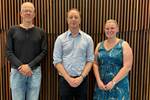UniSQ, iLAuNCH Trailblazer program drive digital twin innovation for composite repairs
Working with Boeing Australia, Memko and Dassault Systèmes, the University of Southern Queensland (UniSQ) has developed a digital twin via the 3DEXPERIENCE platform, digitizing processes that could lead toward more efficient and effective maintenance, repair and operations of future fleets.
Share
Read Next

The Centre for Future Materials (CFM) is UniSQ's research center in advanced composite materials and manufacturing. Source | Dassault Systèmes
Back in November 2023, Australia’s iLAuNCH Trailblazer program — which aims to address critical skill gaps and accelerate the development of Australia’s space sector — announced its backing of a University of Southern Queensland (UniSQ) project, targeting faster and more efficient aircraft and spacecraft composite repairs. Supported by Boeing Australia and engineering services company (Melbourne), the university’s Centre for Future Materials (CFM) has since innovated a digital twin using Dassault Systèmes’ (Vélizy-Villacoublay, France) 3DEXPERIENCE platform to digitize the composite repair process.
“MEMKO brings to UniSQ access to the Dassault Systèmes virtual twin software and their engineering expertise with these tools, which enables the virtual replication of a product along its whole life cycle — from digital design through to manufacturing requirements or in this case, structural repair,” says iLAuNCH Trailblazer executive director Darin Lovett.
Dr. Tristan Shelley from the UniSQ CFM has been heading the research, with the ultimate goal of increasing the digitalization of manufacturing processes for composite materials. In addition, to complete the project, the UniSQ installed scholarships for three Ph.D. opportunities to work alongside engineers and scientists at Boeing Aerostructures Australia and Memko in Melbourne, Brisbane and Toowoomba in an effort to develop workforce development and upskilling programs.
Almost two years later, the iLAuNCH Trailblazer project has seen much success, which Dassault Systèmes has detailed in this customer story . Using the 3DEXPERIENCE platform’s digital twin capabilities, Shelley and his team have been doing everything from damage detection and capturing real-time visual data from filament winding to predict and optimize the best wind path, to programming scarfing tool paths, all in the name of eliminating both engineering and laborious processes and creating greater precision in the composite repair process.
“We are refining the NDT [nondestructive testing] process to help engineers identify the repairs area faster and more precisely,” Shelley says in the article. “We use reverse engineering capabilities within the 3DEXPERIENCE platform to read the processed NDT data. This enables the creation of topology (the properties that remain unchanged under continuous deformations) which in turn can be overlaid with actual CAD data. This allows us to analyze and improve the visibility of internal layers to identify the size and extent of the damage.”
for more details about the project’s process, successes and next steps.
Related Content
-
Combining multifunctional thermoplastic composites, additive manufacturing for next-gen airframe structures
The DOMMINIO project combines AFP with 3D printed gyroid cores, embedded SHM sensors and smart materials for induction-driven disassembly of parts at end of life.
-
The potential for thermoplastic composite nacelles
Collins Aerospace draws on global team, decades of experience to demonstrate large, curved AFP and welded structures for the next generation of aircraft.
-
The next-generation single-aisle: Implications for the composites industry
While the world continues to wait for new single-aisle program announcements from Airbus and Boeing, it’s clear composites will play a role in their fabrication. But in what ways, and what capacity?






